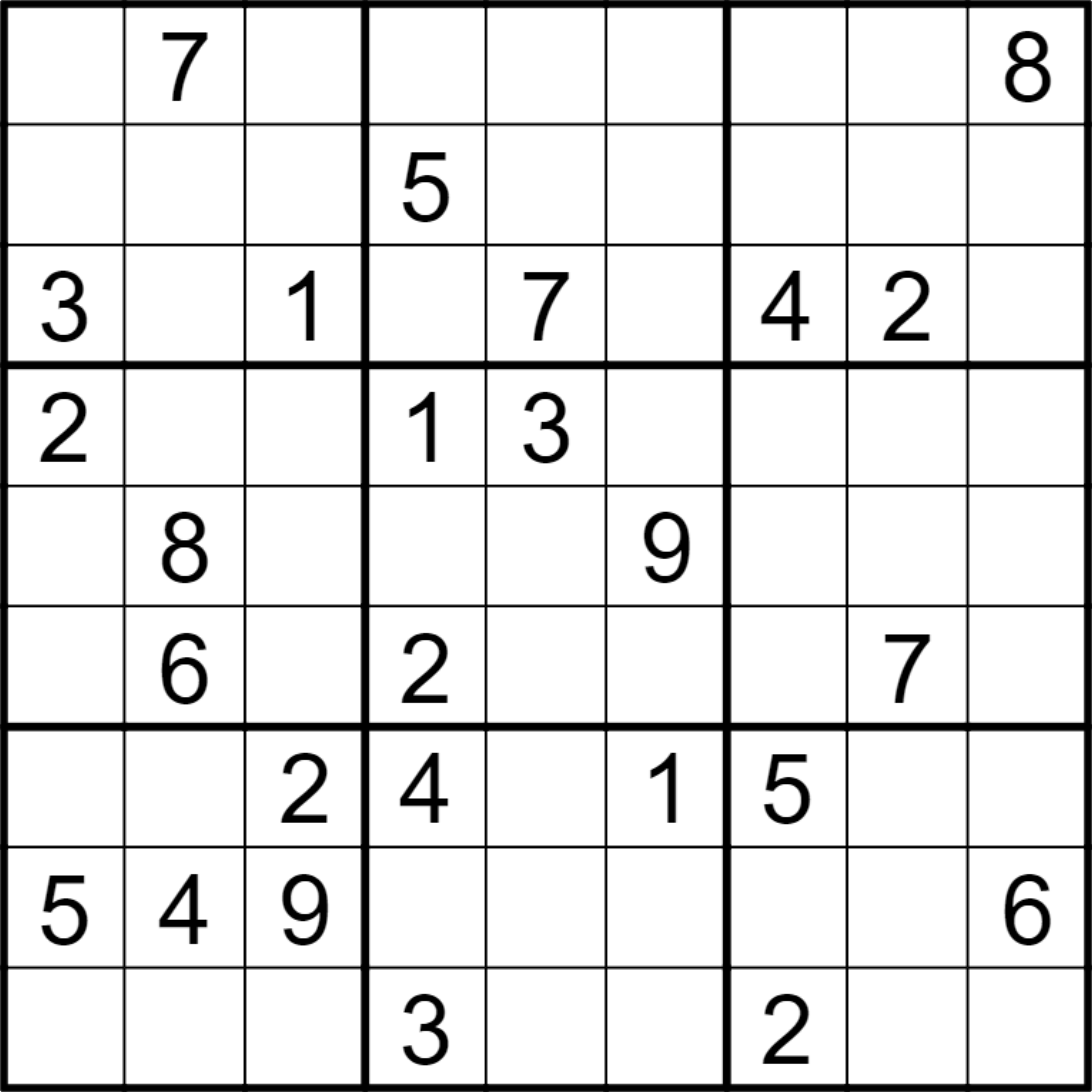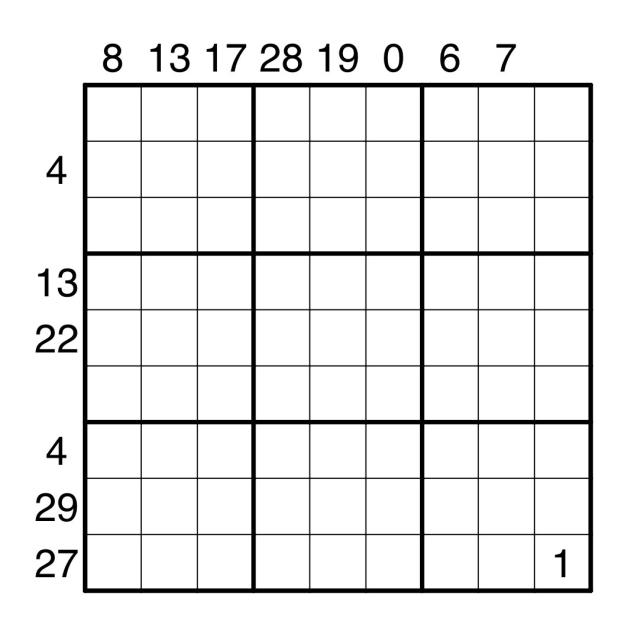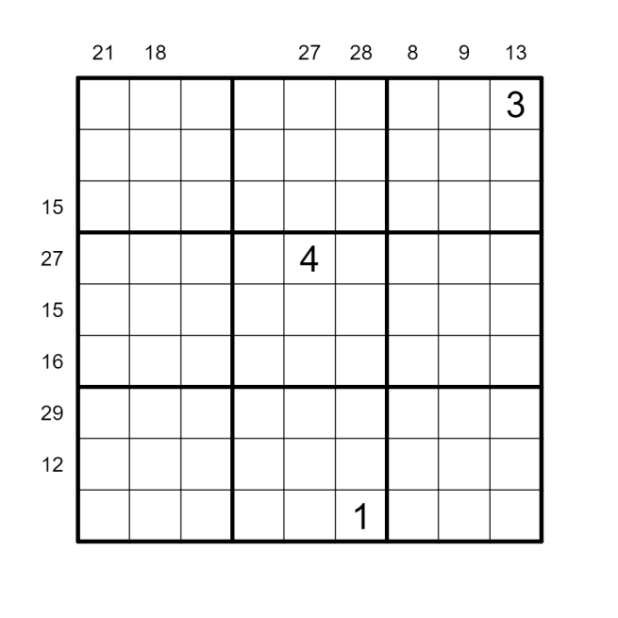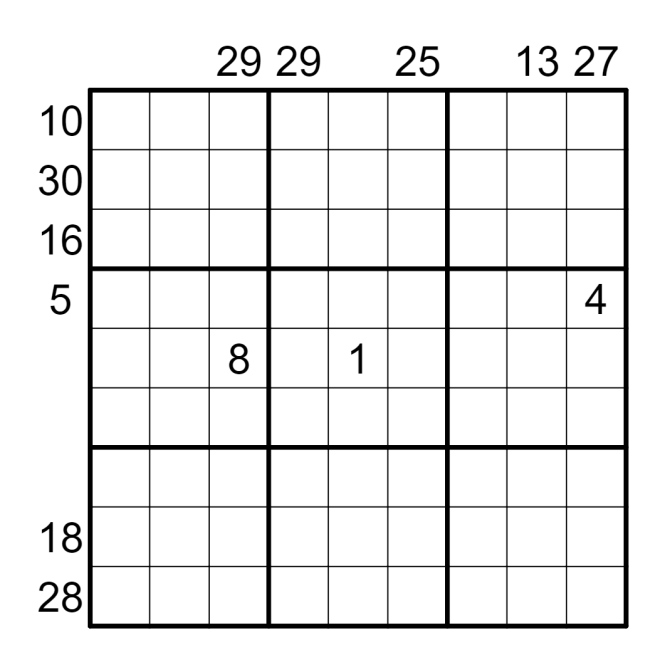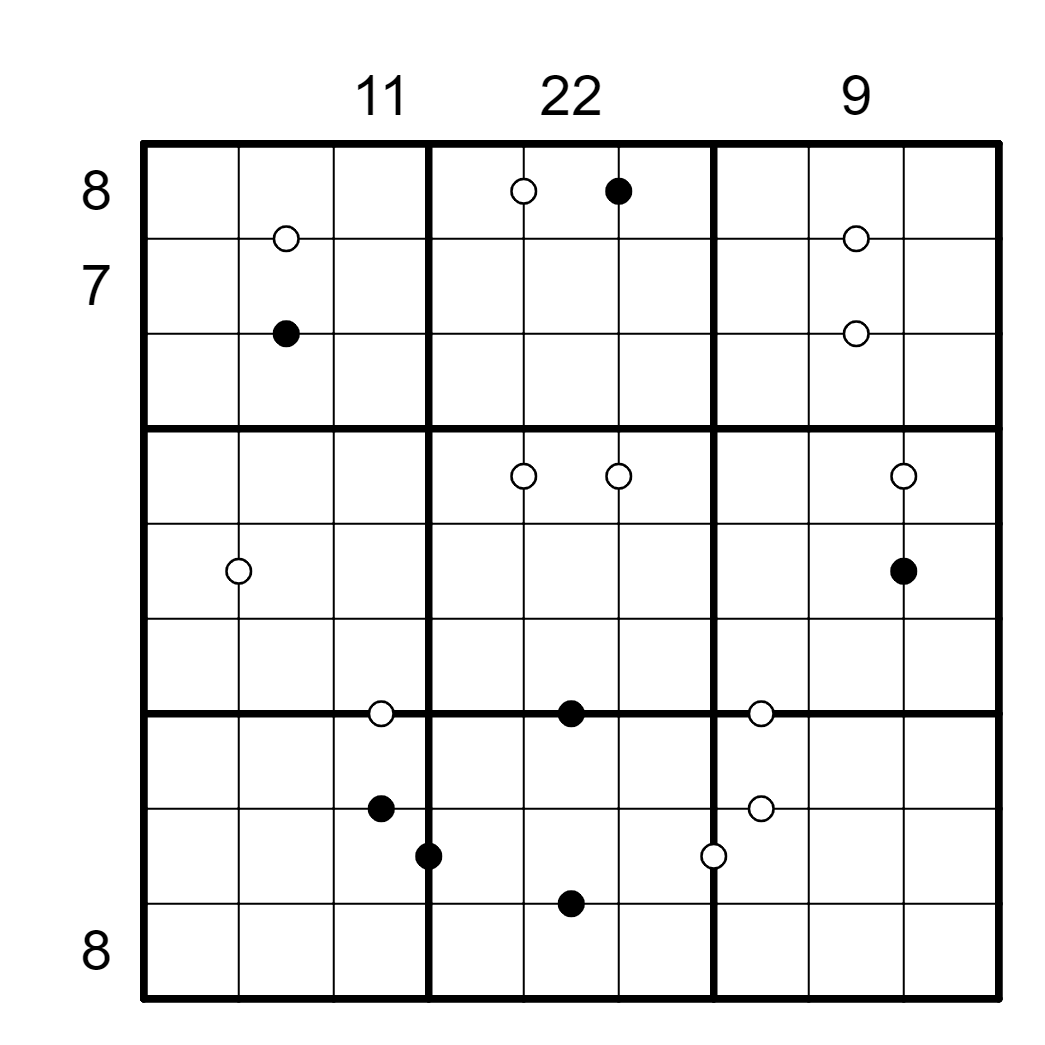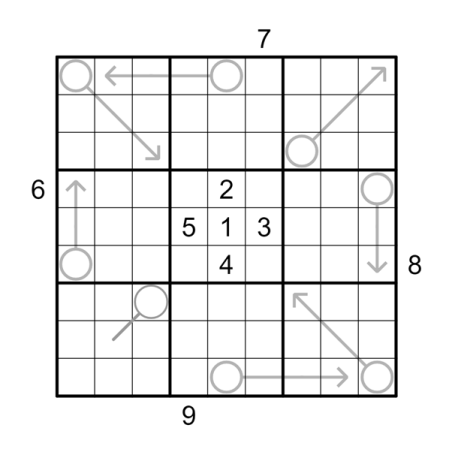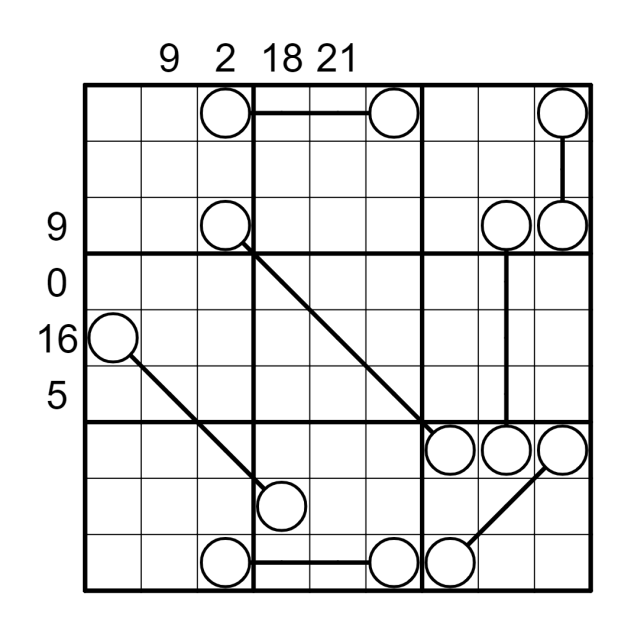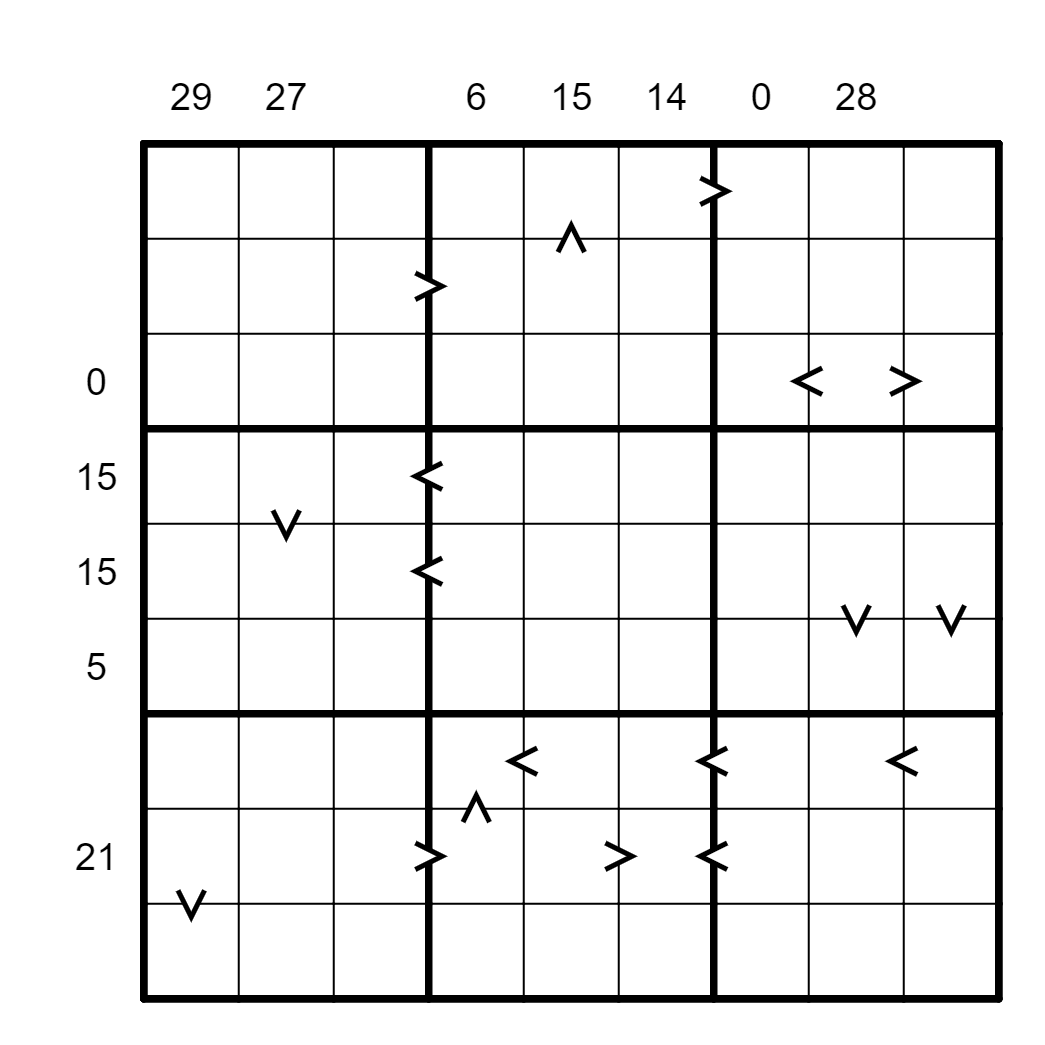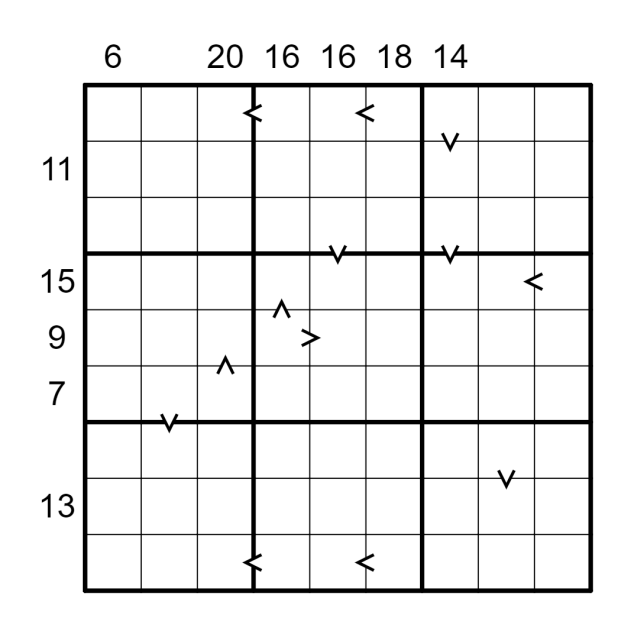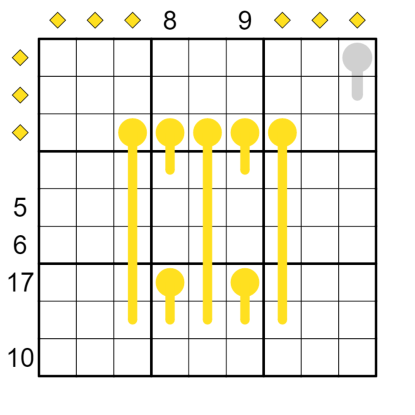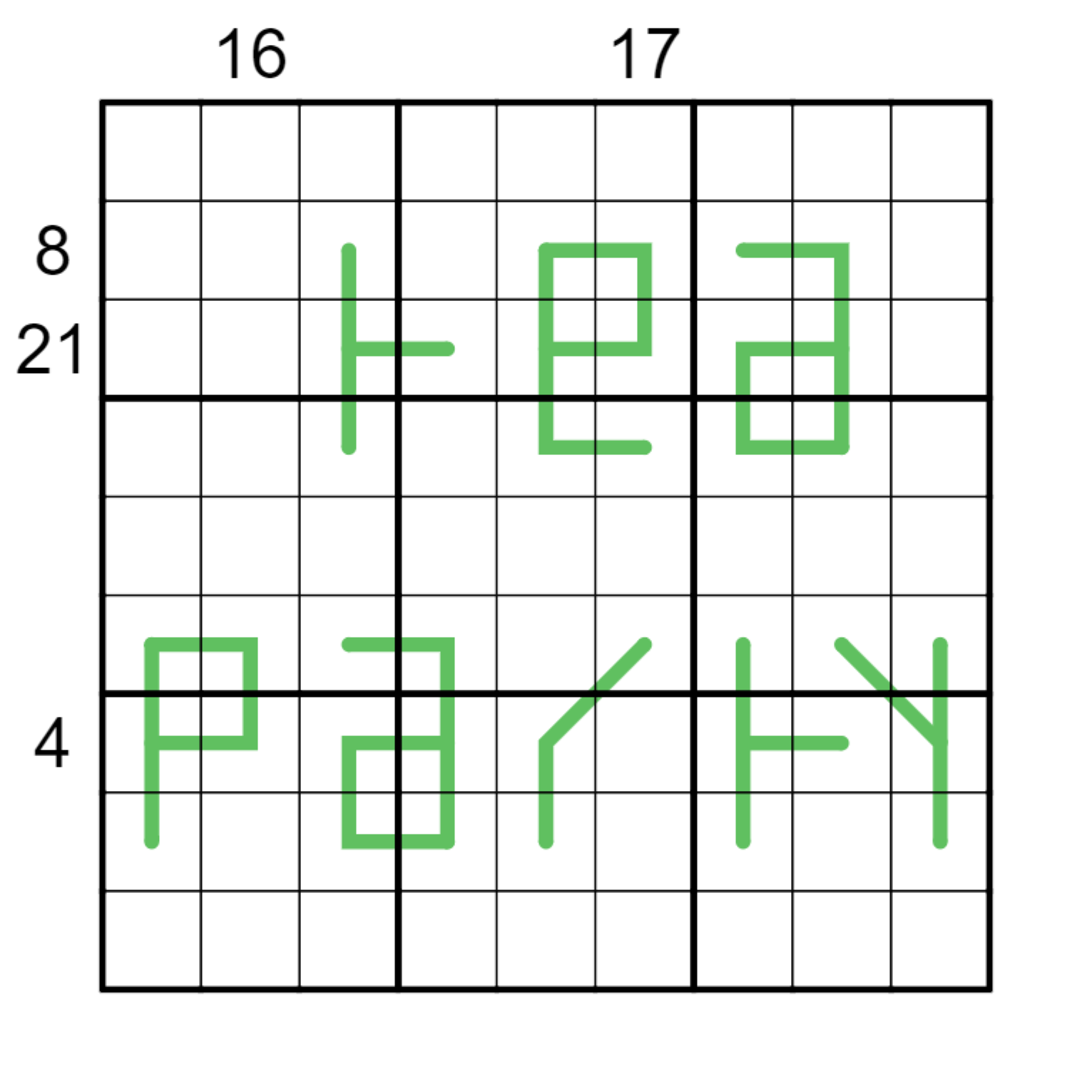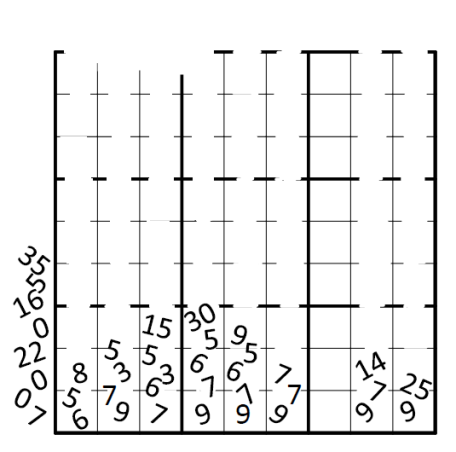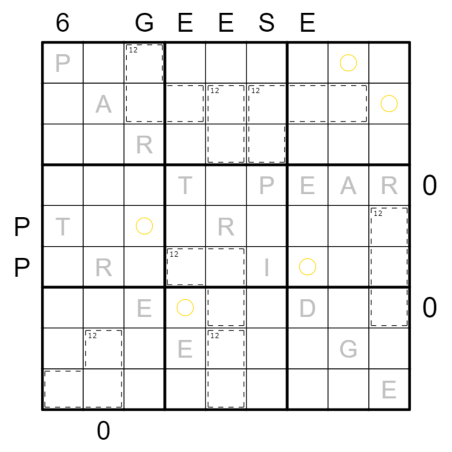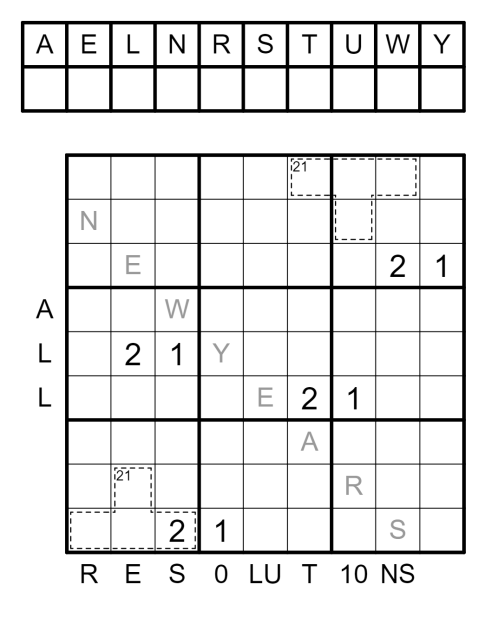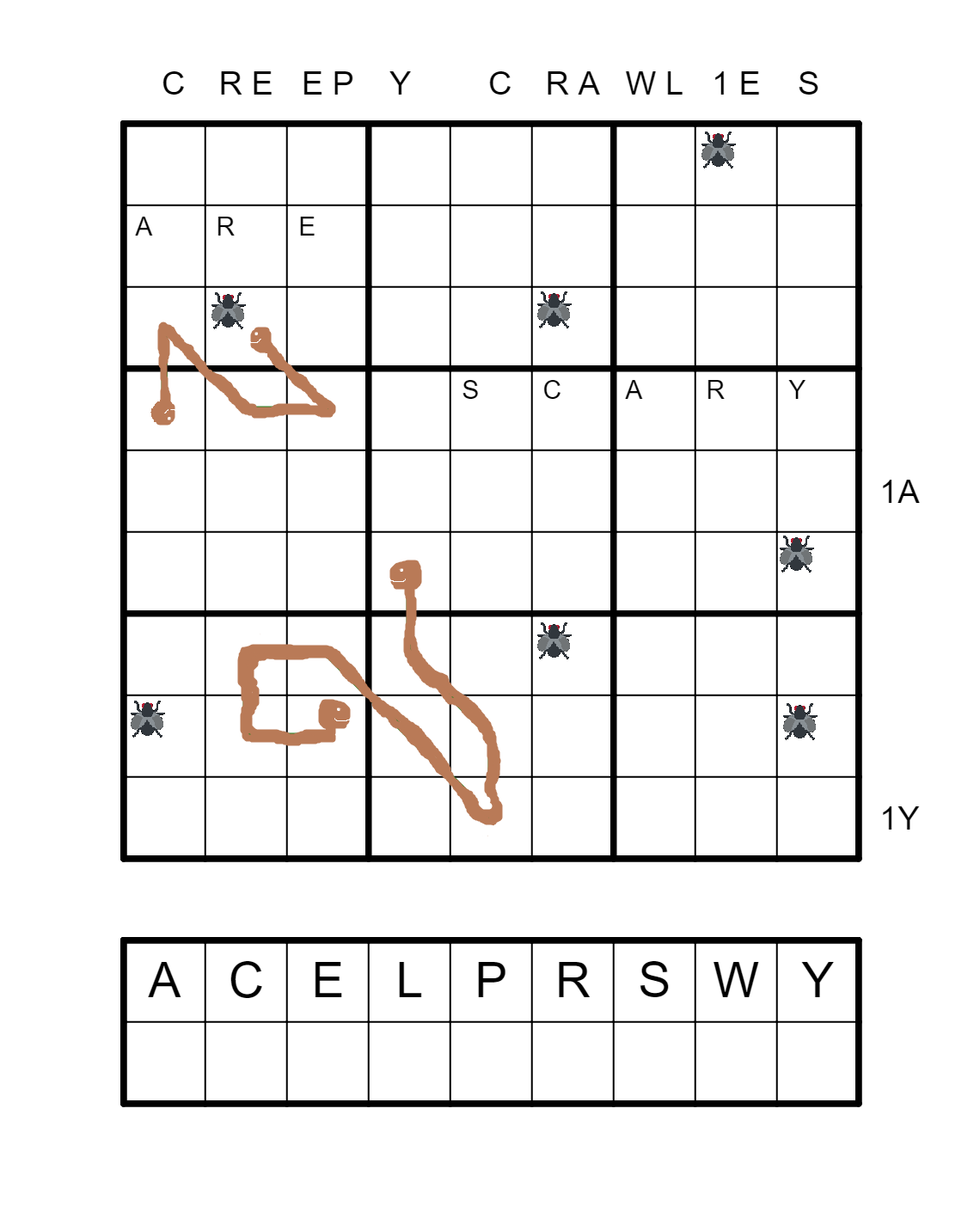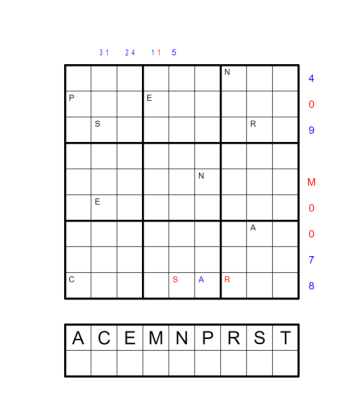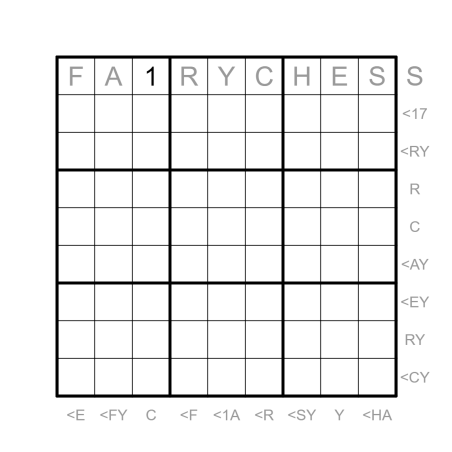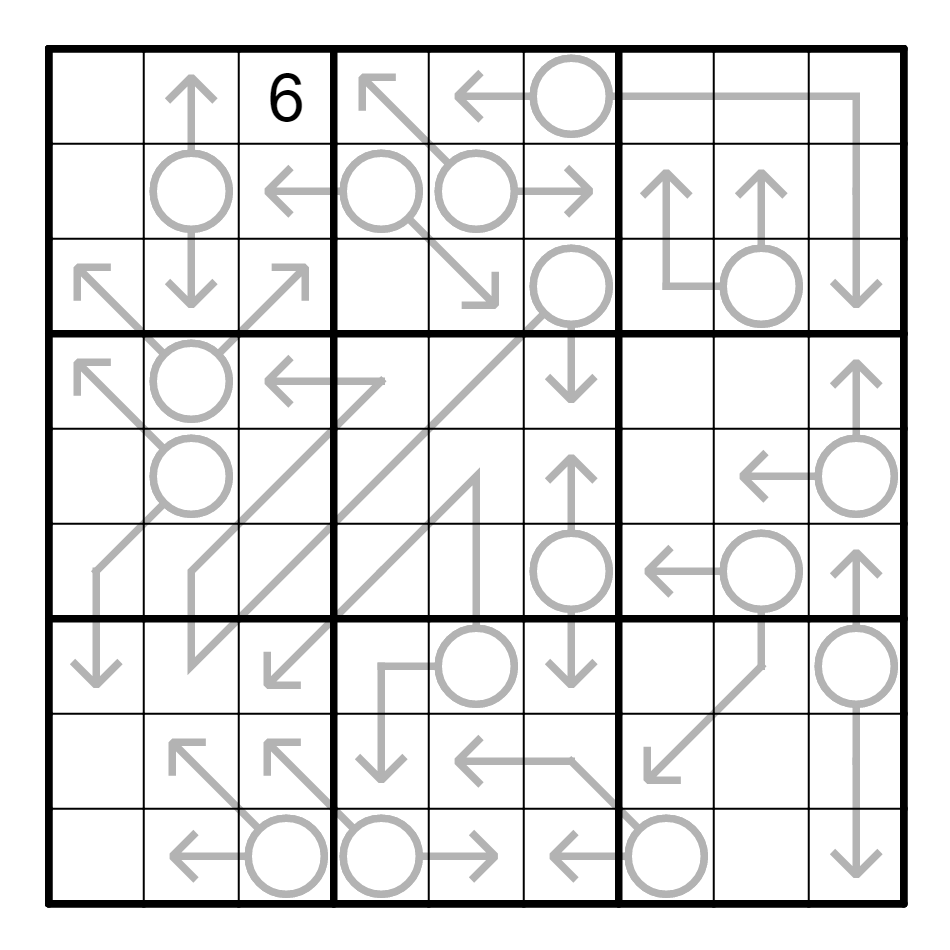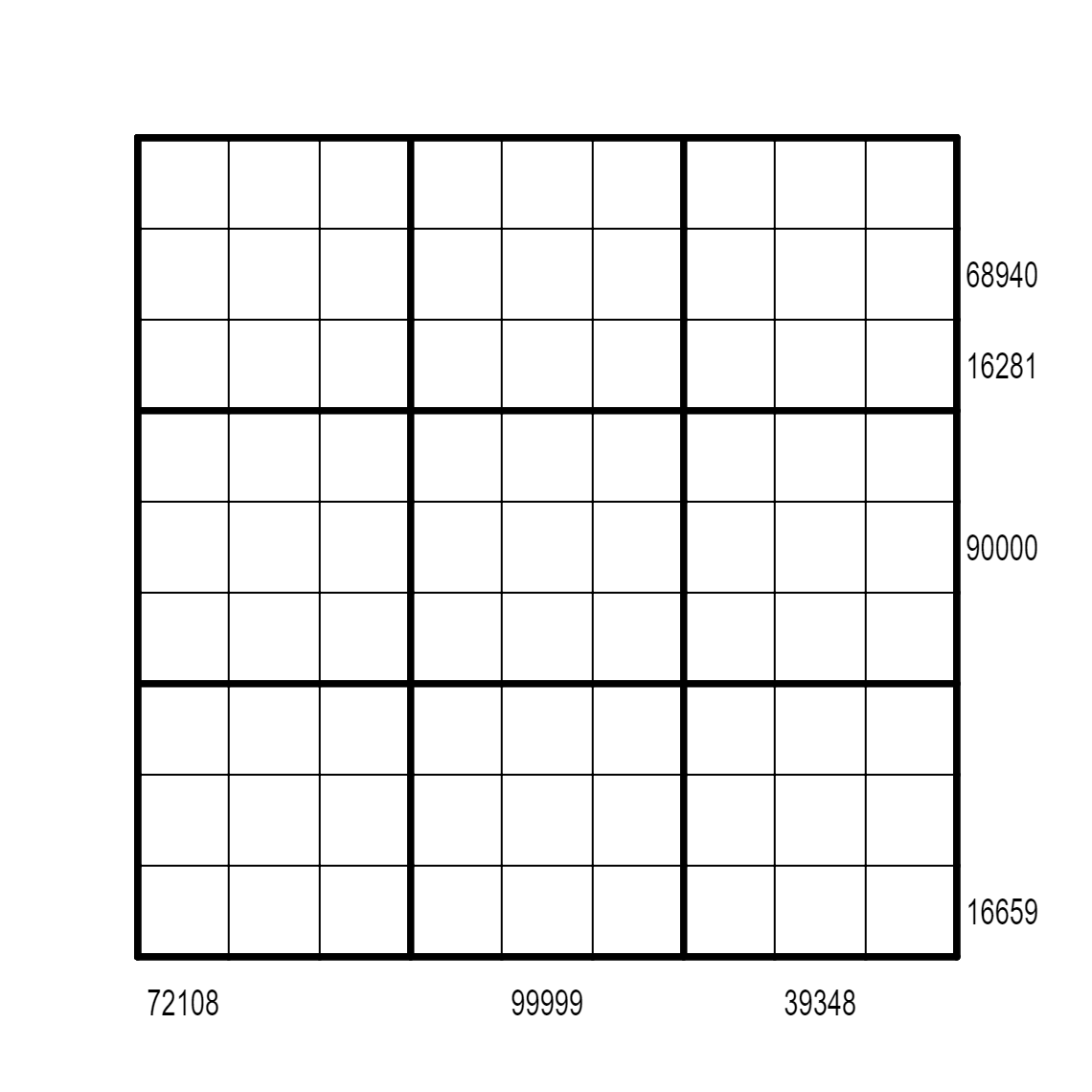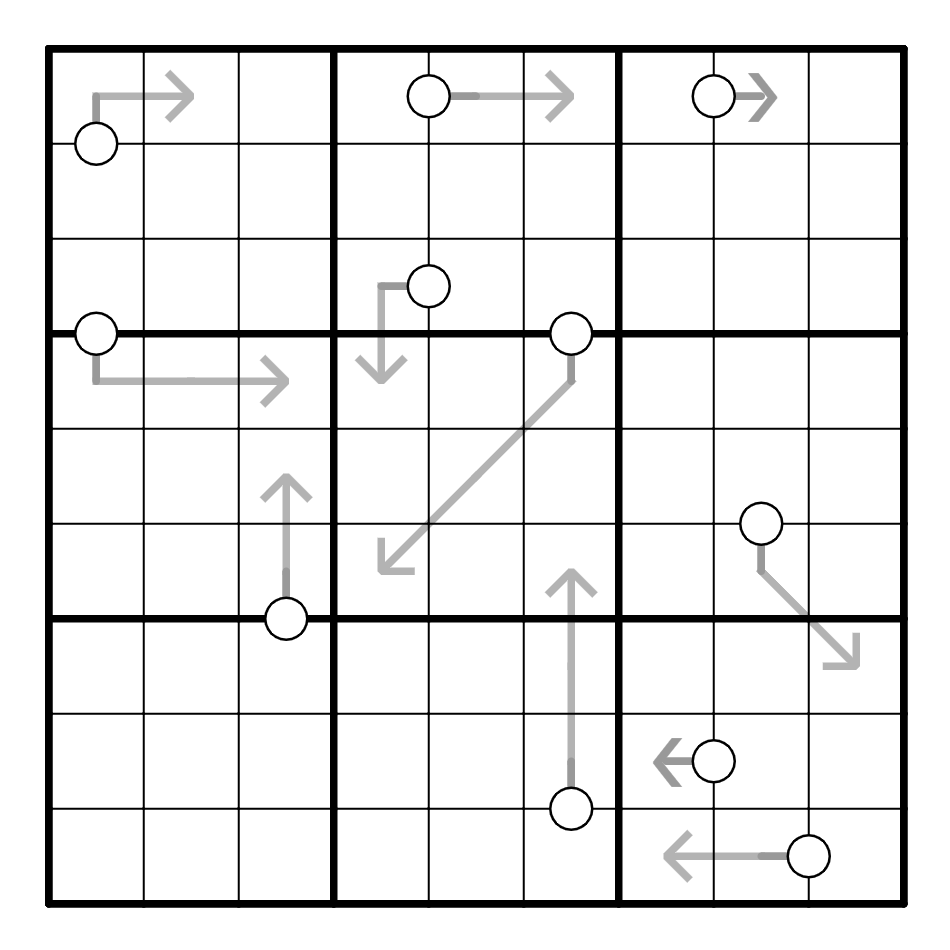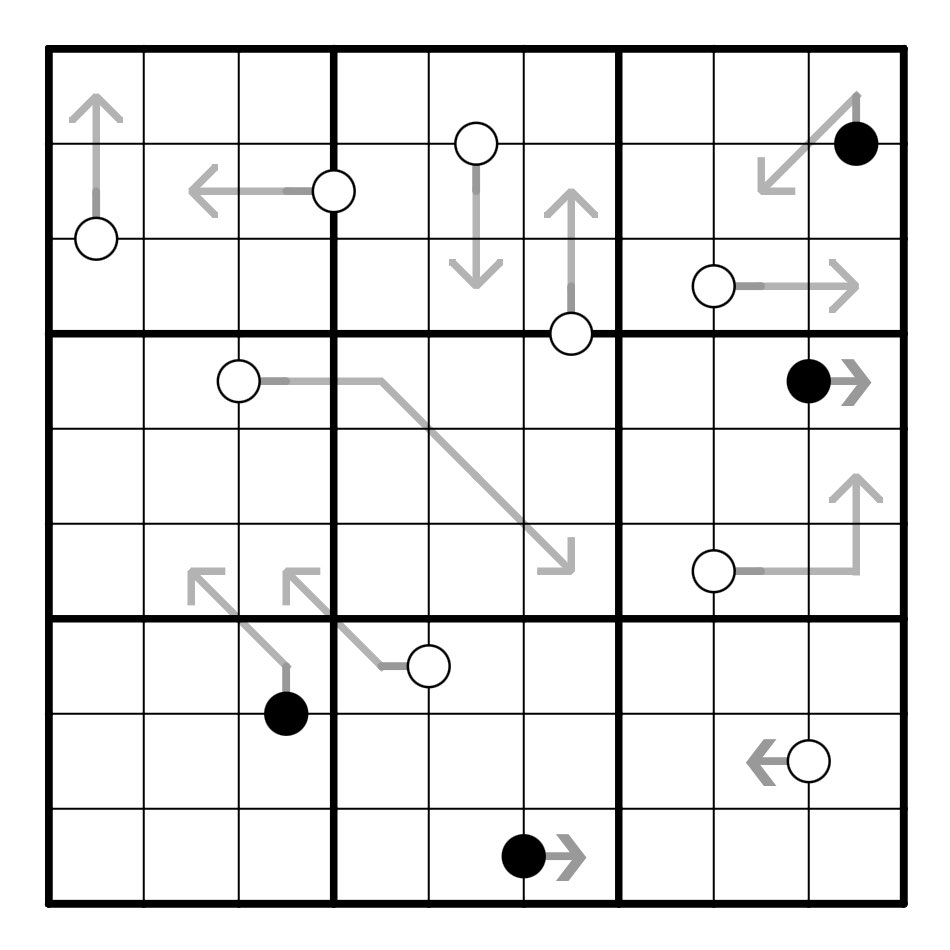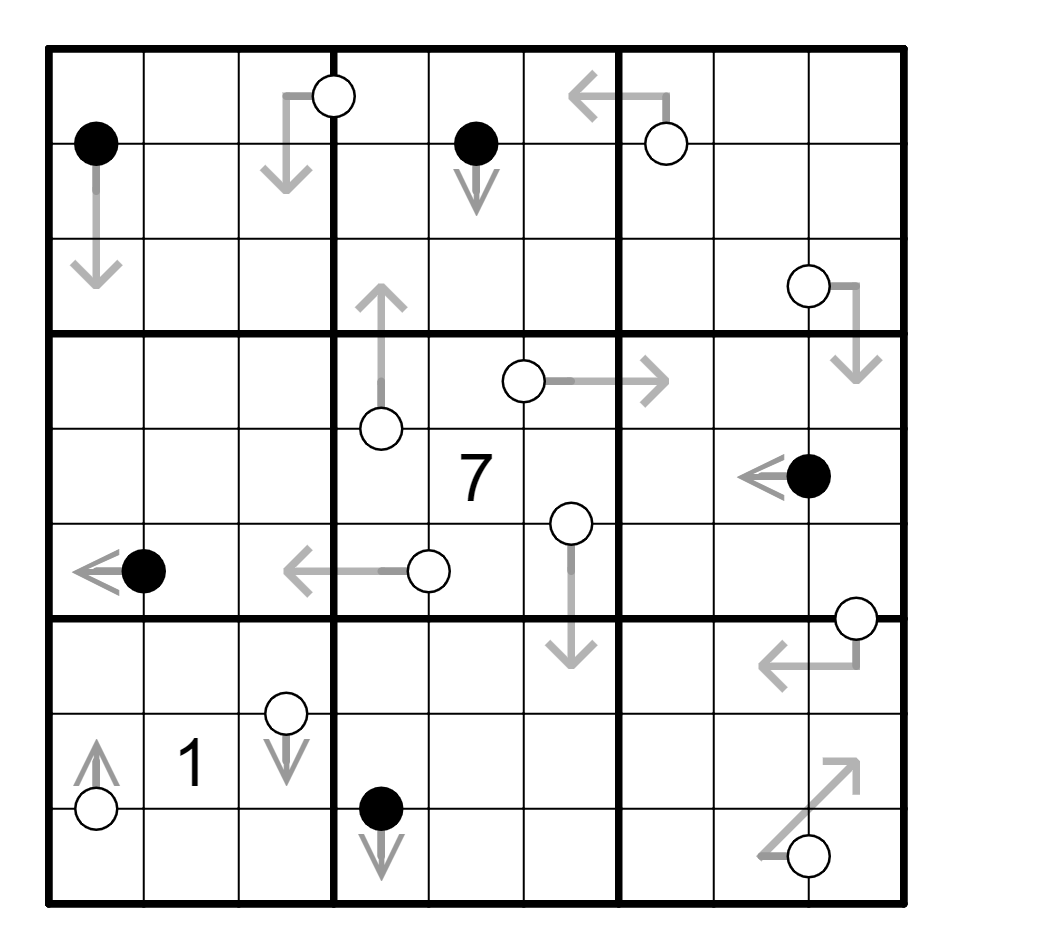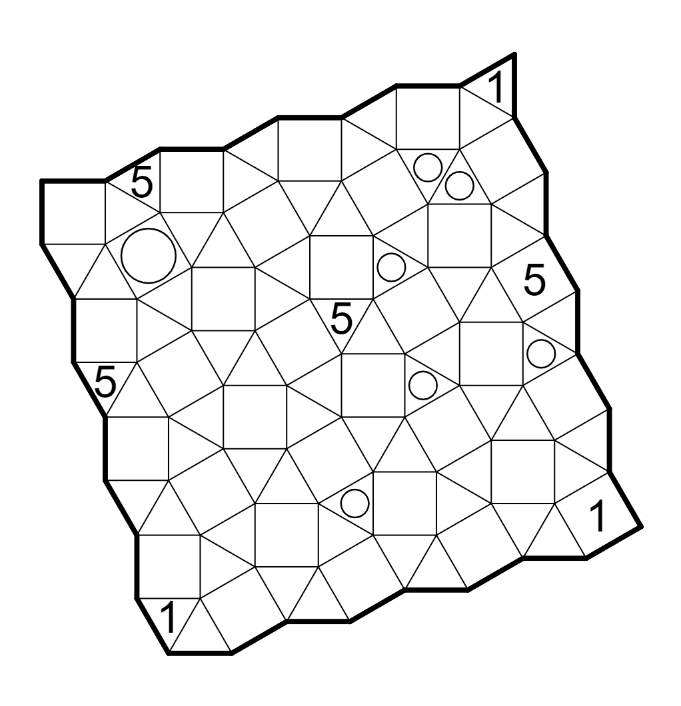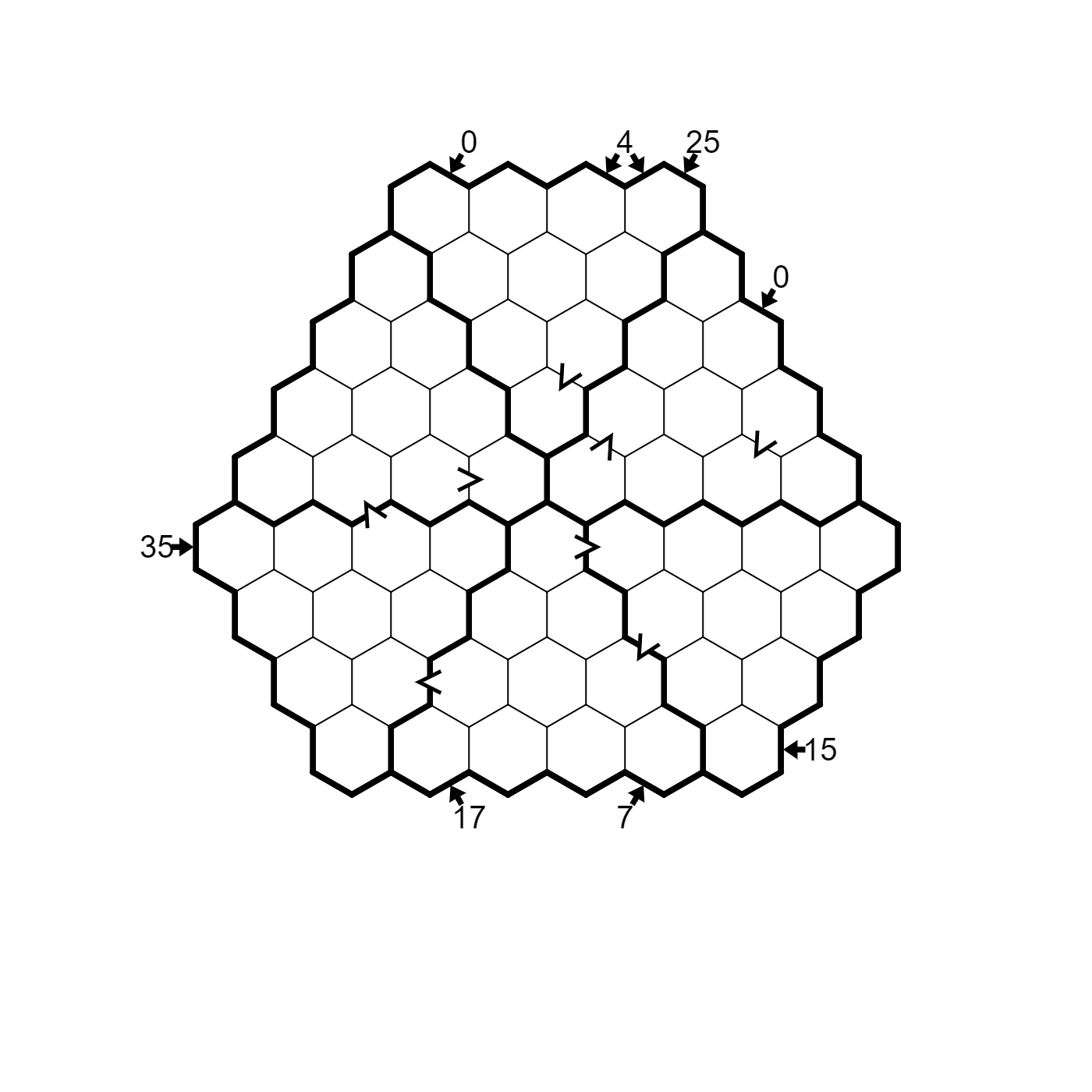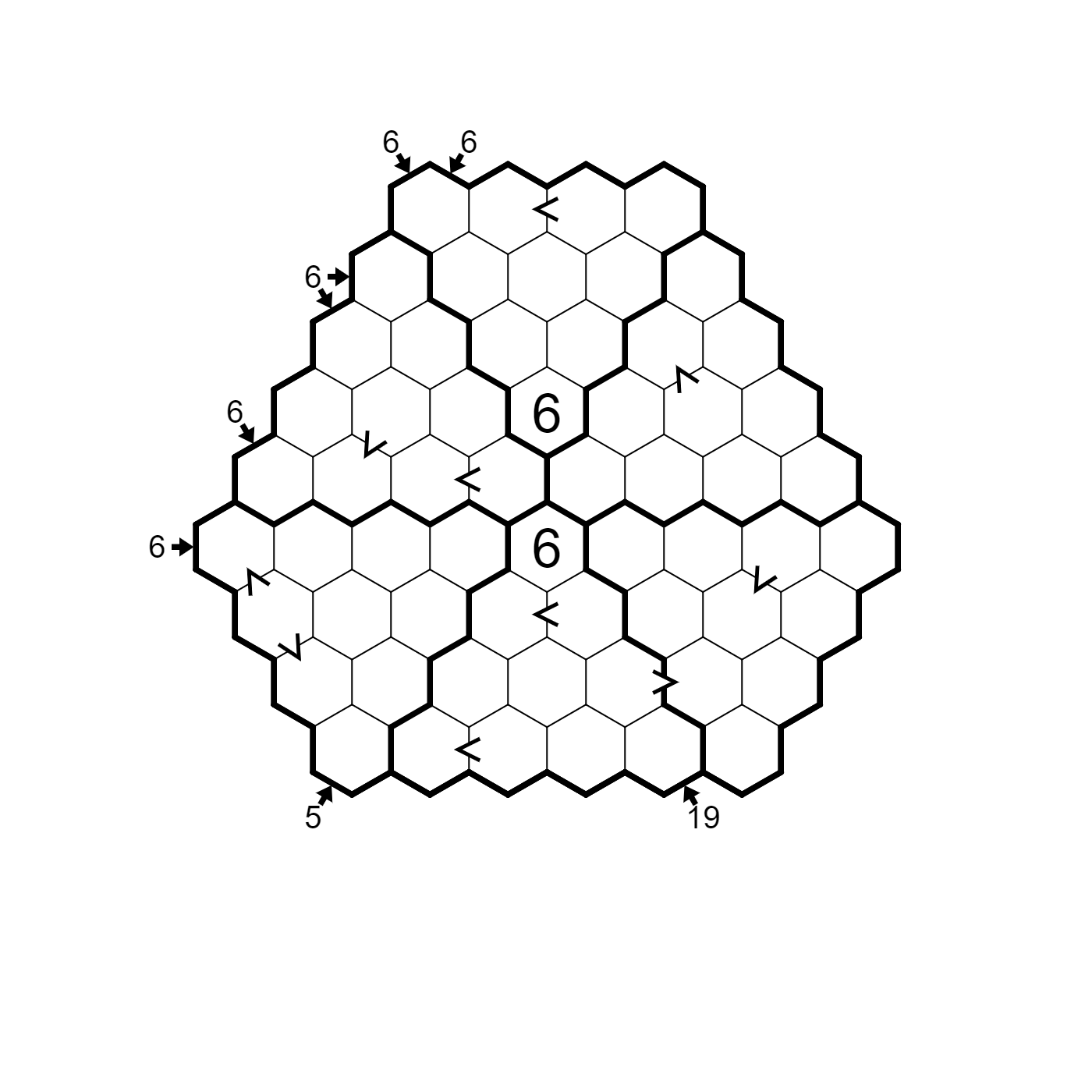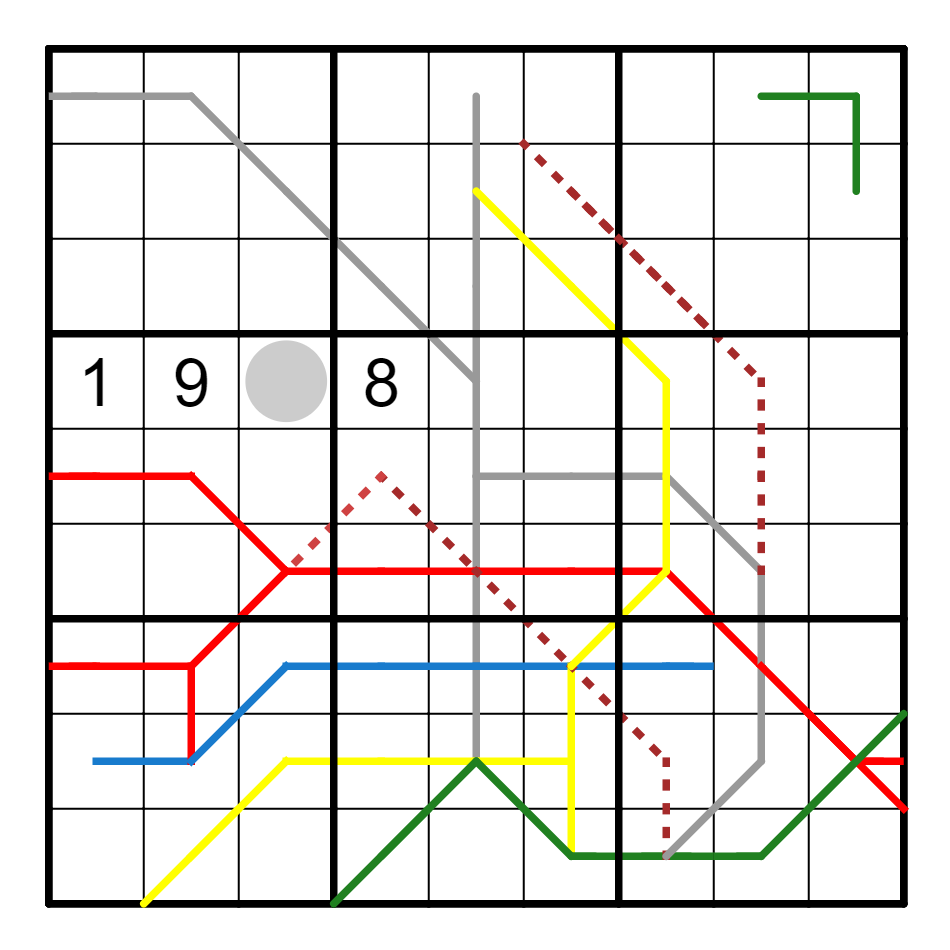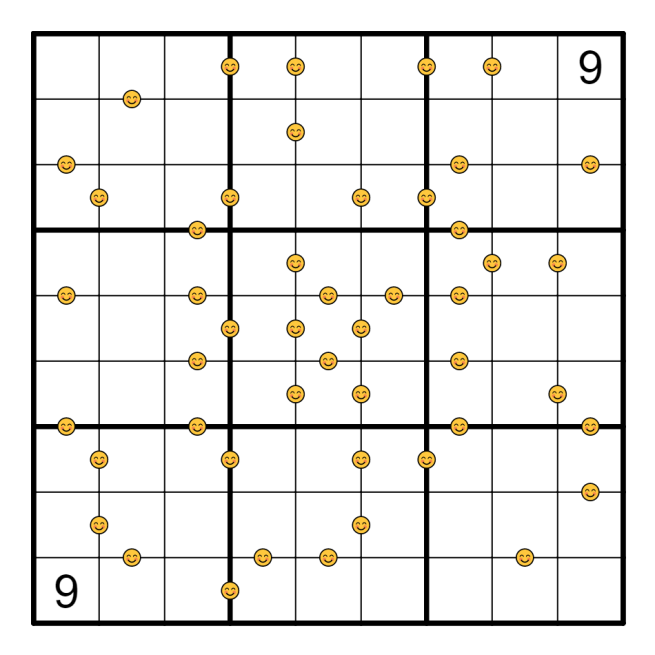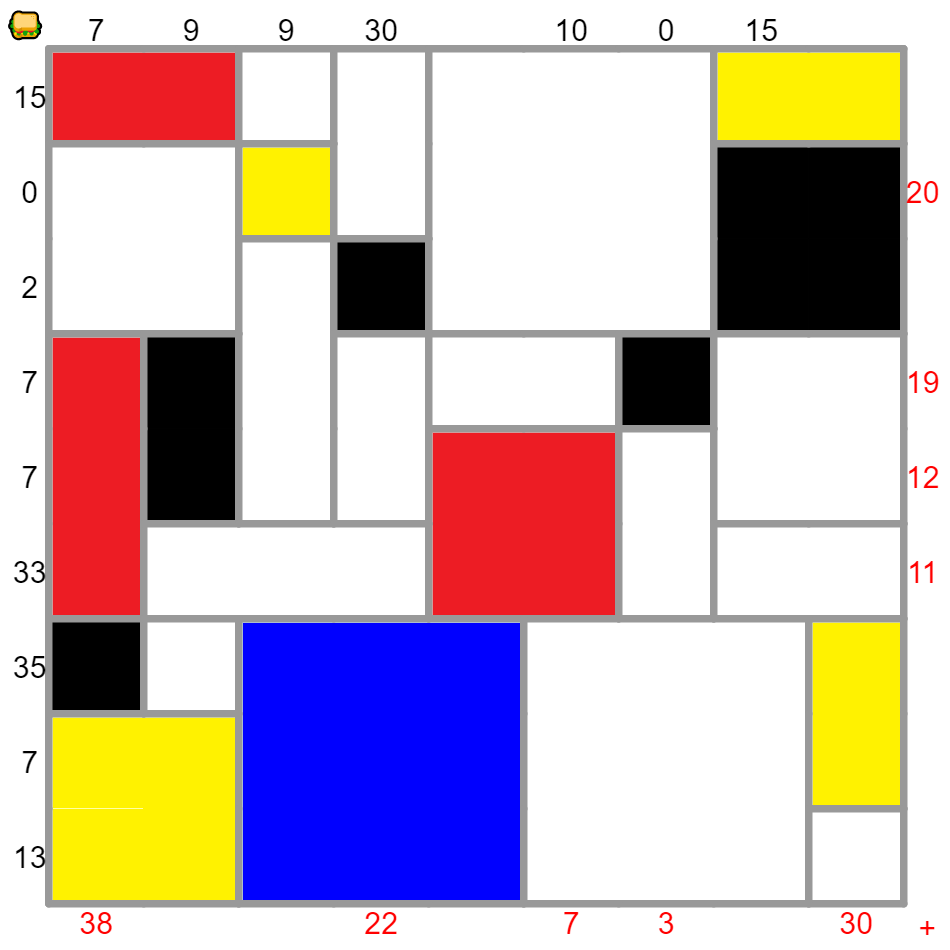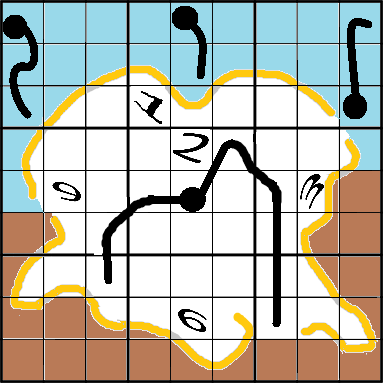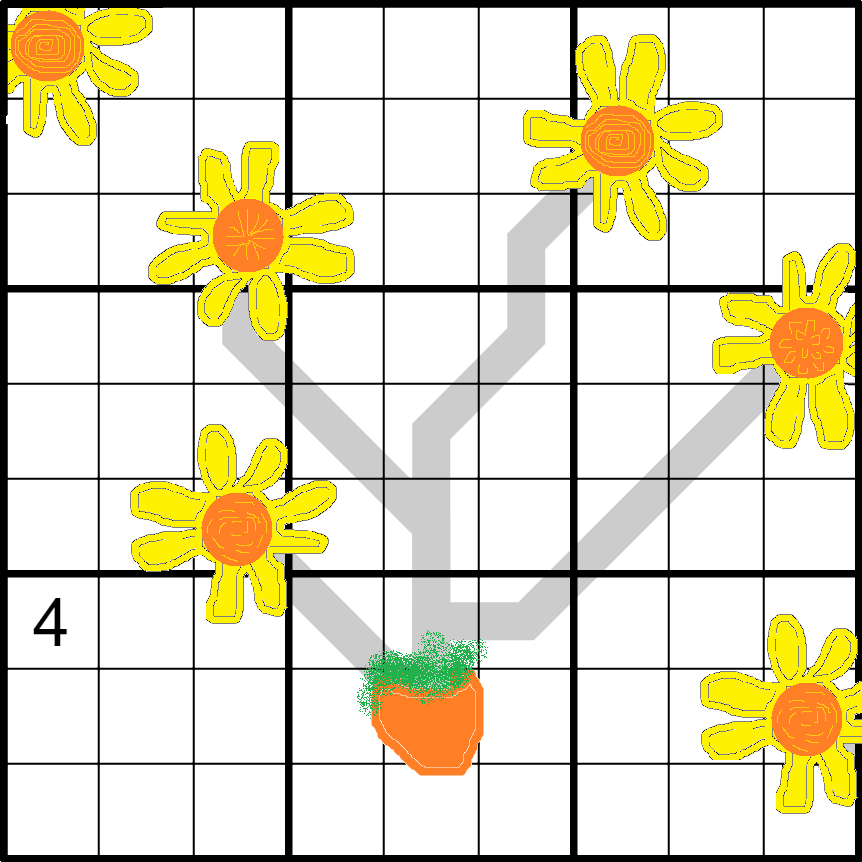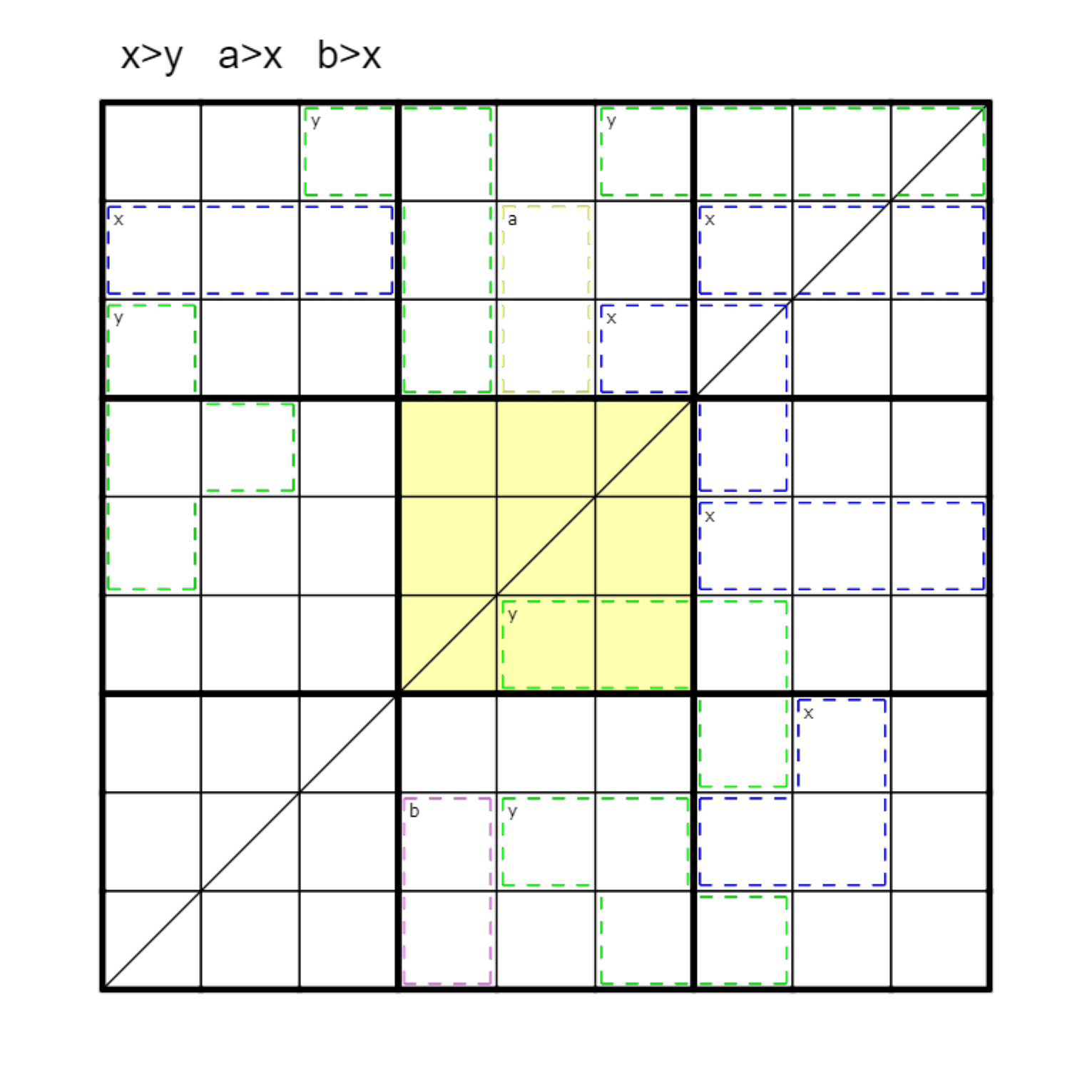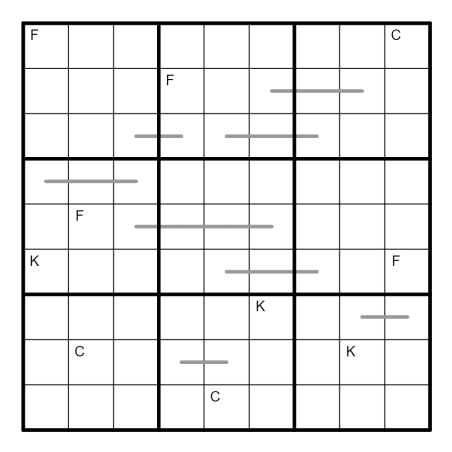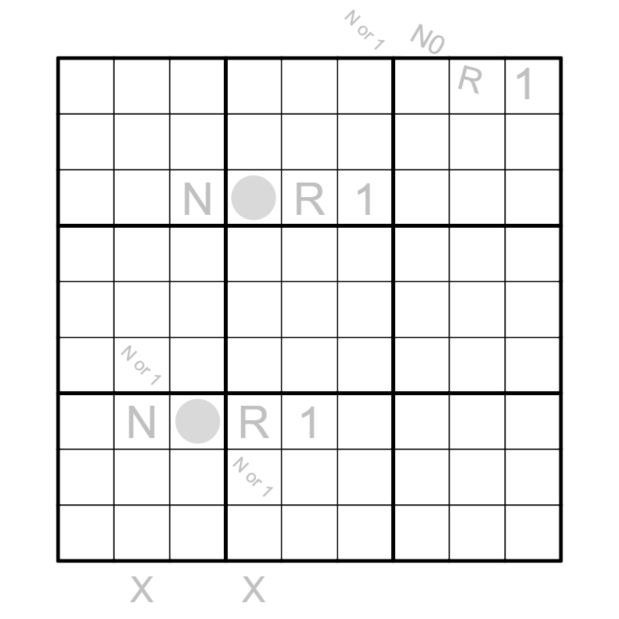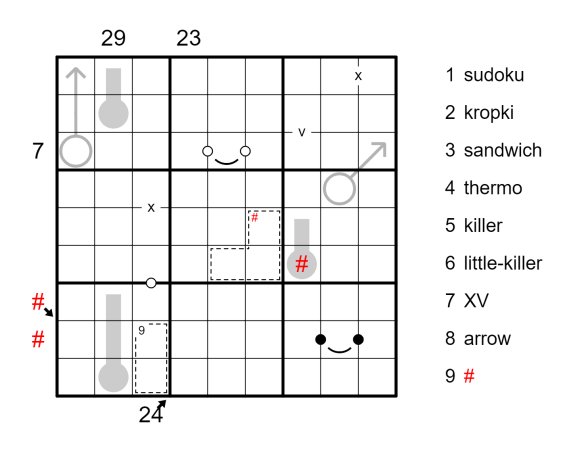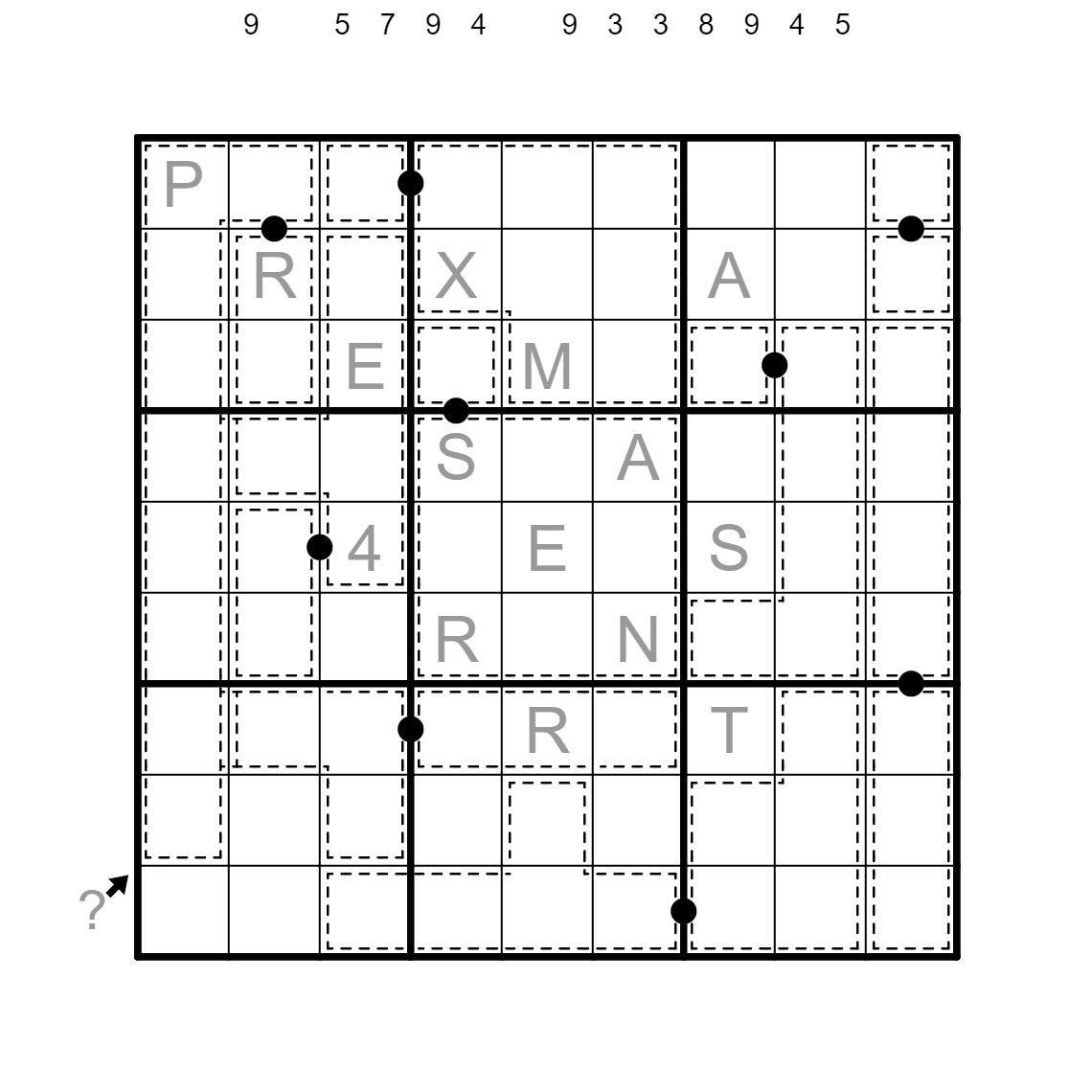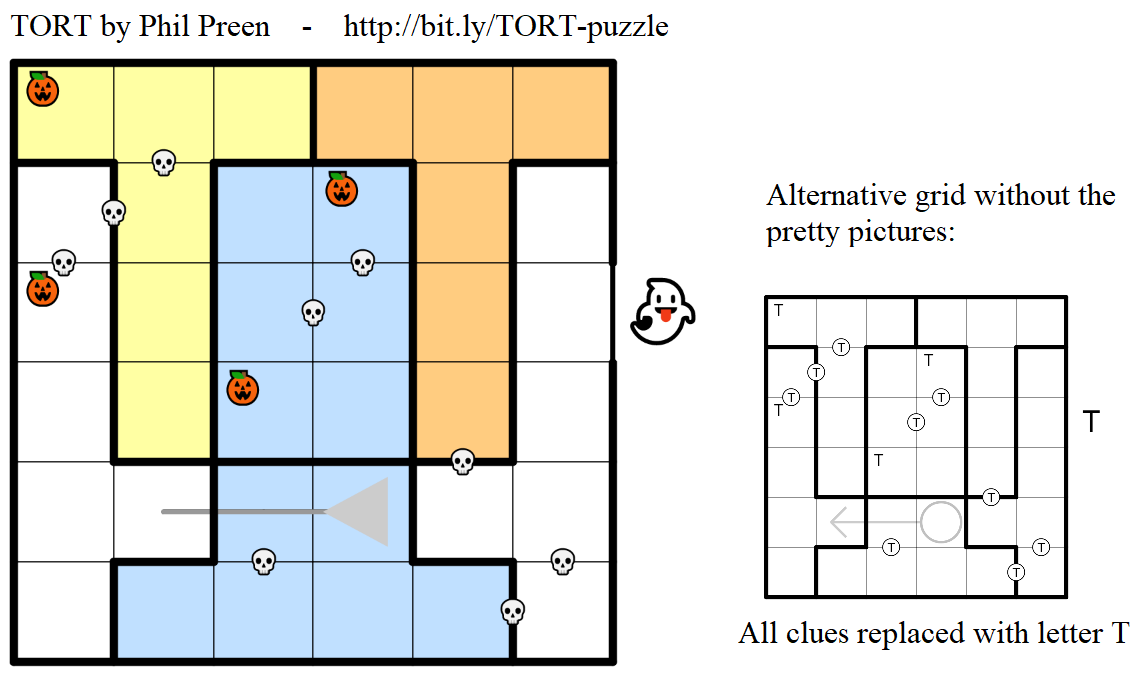Play some of my sudoku variant puzzles here.
I have had a passing interest in sudoku and killer sudoku puzzles for some time. During the Coronavirus lockdown I discovered the Cracking The Cryptic YouTube channel. This opened up to me a whole new world of sudoku variant puzzle types that I had been completely unaware of.
The CtC channel and the CtC fan discord server have also helped improve my knowledge of sudoku solving techniques, although I am still pretty bad at it. Most of the puzzles that I make, I would probably not enjoy solving very much myself. I make mistakes easily and get frustrated when I go wrong. I tend to prefer slightly easier puzzles, but when setting puzzles, I do like to try to make the solver do a bit of work to find the solution.
Classic Sudoku
Many sudoku puzzles nowadays that you find in newspapers (and websites that offer lots of puzzles) will be computer-generated. These can be OK but some of them aren't much fun. The best puzzles are those that have been hand-crafted by a real person as you know there will be some interesting logic involved that has been specifically designed into the puzzle, rather than a computer just randomly putting in clues according to some algorithm. The best human setters will place the given digits in such a way as to lead you through the solve in a satisfying way, or they will present the clues helpfully in order to telegraph that a particular technique is required or to subtly point you in the right direction.
Most of the puzzles I have made have been variant puzzles. i.e. there are rules or constraints additional to the normal sudoku rules. I find classic sudoku very difficult to set. Sudoku variants with additional constraints gives me more options to make puzzles interesting.
Currently I just have the one classic sudoku puzzle. It is not too difficult if you know some of the basic techniques. I did get some nice comments on this puzzle in the CtC fan discord server.
[Classic Sudoku]
Sandwich Sudoku
One of the standard sudoku variants that I enjoy is known as Sandwich Sudoku, or Between 1 and 9 Sums. I have written quite a number of puzzles combining sandwich sums with other variant rulesets. Here are a few that are straightforward sandwich sudoku without any additional rules.
[Sandwich Sudoku] [Sandwich Sudoku] [Sandwich Sudoku]
Combining sandwich rules with Kropki Pairs
Kropki is the polish word for dots. Kropki Pairs Sudoku have dots between squares. A white dot indicates that the two squares have a difference of 1, i.e. they contain consecutive digits. A black dot indicates that the two squares have a 2:1 ratio, i.e. one digit is half the value of the other.
[Kropki Pairs Sandwich Sudoku]
Combining sandwich rules with Sudoku Arrows
In Arrow Sudoku some cells in the grid containing a circle, and each circle has one or more attached arrow. The sum of all the digits along an arrow always equals the value of the digit in the circle.
[Arrow Sandwich]
Combining sandwich rules with Between Lines
Between Lines is an interesting variant constraint. Lines connect two cells, each of which contains a circle. The digits in the squares that the line passes through are always 'in between' the two digits in the circle. i.e. one of the circles contains a digit higher than every digit on the line, and the other contains a digit smaller than the digits on the line.
[Between Lines Sandwich]
More Than Sandwich
Here are a couple that combine sandwich sudoku with inequality signs between squares. These tell you which of the two squares is the largest.
[More Than Sandwich Sudoku] [More Than Sandwich Sudoku]
Combining sandwich rules with Thermos
Thermometers (aka Thermos) in sudoku are a bit like inequality signs. Digits along a thermometer must strictly increase, starting with the lowest digit in the bulb.
[Casket of Gold]
Combining sandwich rules with German Whispers
Adjacent digits along a German Whispers line always have a difference of at least 5.
[German Sandwich Whispers]
[Whispers about sandwiches at Mad Phil The Hatters Tea Party ]
Sandwich rules with misplaced clues
Sometimes puzzle setters like to be a bit sneaky and move the clues somewhere else in the grid than where they are supposed to be. There will be some logical way to find out the correct placement though and solve the puzzle.
[Broken Sandwich Sudoku]
Sandwich rules with crypto-clues
Crypto-clues are given digits, sandwich sum values, or other clues where the numbers (or each digit in 2-digit numbers) is replaced with a letter of the alphabet. So, in order to solve the puzzle you will need to also figure out which letter represents which digit.
These can be quite fun as the letters can sometimes make words in the grid. I have found this useful when making puzzles with a specific theme. e.g. for the Monthly CtC discord server puzzle prompt.
Some of these puzzle also have killer cages or other variant constraints to help you solve the puzzle.
[Killer partridge in a pear sandwich] - featured on CtC with Simon Anthony
[New Year's Resolutions]
[Creepy Crawlies Are Scary] - featured on CtC with Mark Goodliffe
[Bicycle Repair Man]
[Super hero sudoku]
[Fairy Chess Sudoku]
New variants of my own devising
I have come up with a couple of ideas for potential new variant sudoku puzzles. To my knowledge, no-one else has yet taken up my ideas and produced their own puzzles using these rules. You may still find these puzzles interesting though. Please let me know if you enjoy these puzzles and especially if you have a go at creating your own puzzles using these rules.
Difference Arrows
This is a variation on arrow sudoku. Normally the digits along an arrow sum to the value in a cell containing a circle that is attached to the arrow. In this variant, when there are two arrows from the same circle, the value in the circle is the difference between the two arrow sums.
[Difference Arrows] [More Difference Arrows] [Difference Arrows - first version]
Find The ➕
In this new variant you have to imagine a plus sign between two cells in a row or column of the grid. When read left to right in the row or top to bottom in this column, this results in a sum of two numbers. The outside clue gives the result of this sum.
[4x4 taster puzzle] [Find The ➕ No 1] [Find The ➕ No 2]
Kropki Arrows
In standard Arrow sudoku the sum of all the digits along the arrow must equal the digit inside the circle attached to the arrow. This is the same in this variant except that the circle is not in one of the cells of the sudoku grid. Instead it is a 'kropki dot', i.e. a difference (white circle) or ratio (black circle) clue between two cells. The first puzzle just uses white circles.
[Kropki Arrows 1] [Kropki Arrows 2] [Kropki Arrows 3]
Quad Arrows
Having come up with the kropki arrows idea, I started thinking about what other clues might be represented by circles. I obviously had to come up with a variant using quadruple clues. These are circles that sit on the corner between four cells. Each digit in the circle must appear in one of these four surrounding cells. In this variant, the number represented by the digits in the circle is also the sum of all the digits along the arrow.
[Anti-Knight-Quad Arrows]
Other Puzzles
[Snake Sandwich]
[Snub Snake]
[Snub Head]
[Hex Sandwich]
[CtC discord 6000 milestone]
[London Underground Railways 1908]
[Haute Cuisine Sudoku]
[Haute Cuisine Sandwich]
[Snowballs and Snowflakes on the Slopes]
[The miraculous thermo-cog wheel machine]
[Boo!]
[Tricks & Treats & Whispers in The Shadows]
[Arrows on a major scale]
[Ambiguous Kropki Sudoku]
[Modern Art Sudoku - Mondrian]
[Modern Art Sudoku - Dali] - featured on CtC with Mark Goodliffe
[Modern Art Sudoku - Van Gogh]
[Smaller is bigger]
[Ambiguous Thermometer Sudoku]
[Because I'm Mad]
[What is Wrogn?]
[9 5794 9338945]
[Trick or Treat Sudoku]
